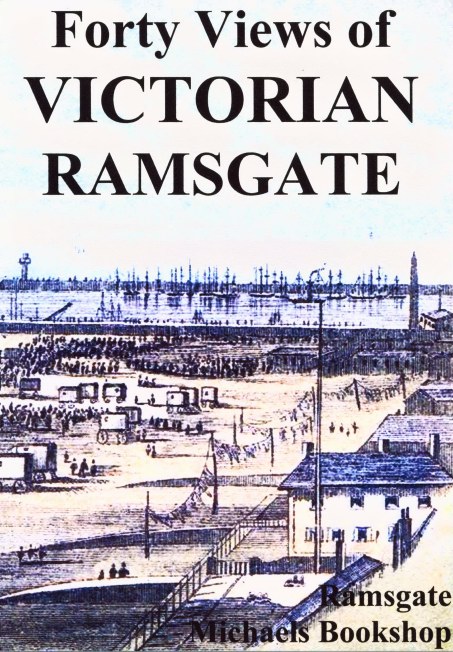Forty Views of Victorian Ramsgate
41 B/W engravings reprinted in a A5 £3.99 and A4 £6.99
In 1736 when John Lewis produced the revised edition of the earliest history of the Isle of Thanet he made it available both in the ordinary edition and a large paper edition. Following the trend in local history books set 330 years ago this is my first attempt at two sizes. This book is available in A5 format at £3.99 and A4 format at £6.99
This book is a collection of engravings of Ramsgate from 1850s to the 1870s they were originally produced in various publications of the period.
You will find them described by “experts” as either etchings or engravings or the more generalised term prints. I suspect that some of them use both techniques however most of the pictures in this book are engravings.
By etching I mean that a small sheet of mild steel or copper is treated by coating with an acid resistant coating, sometimes shellac (beetle droppings dissolved in alcohol) parts of the coating are then scratched away to the metal, which is then dropped into an acid bath, eating away the metal where the ink is going to be. By engraving I mean the metal is scratched with an engraving tool where the artist wants the lines. The printing process is unlike that for type where a platen press is used. The etched or engraved metal plate is inked and then wiped clean leaving the ink in the scratches paper softened by wetting is then laid on the plate both are then sandwiched between two metal sheets and put through a press with steel rollers rather like an old fashioned clothes wringer. The paper is forced into the scratches and so inked. One of the problems for the historian is that engravers or etchers that had never seen the subjects of their pictures produced many engravings and etchings. An artist perhaps would produce a painting another artist make a sketch of it in a gallery and then an engraver would then make an engraving from the sketch. This produced anomalies like the one entitled “Ramsgate Harbour from the Royal Albion Hotel” where among other inconsistencies a whole cliff has appeared in the right of the picture. These mistakes are generally referred to technically as artistic licence. The results of this are particularly unusual where the artist is illustrating something he has never seen at all described in the text of the book, some of the early pictures of elephants are quite marvellous.
The engravings for this book were produced for the popular market, you will notice that nearly all of the engravings say Ramsgate on them as not only were they included in books about Ramsgate but were sold separately used for notelets and so on. The writing under the picture appears in copper plate as it was engraved like the picture. In some cases I have replaced the copper plate writing because it was nearly illegible on the original.
Firms like Rock & Co. often produced small books of views of the towns in the British Isles, they produced one of Ramsgate with 30 views of Ramsgate and the surrounding area within. As the individual pictures sell for about £20 to £30 each you can well imagine that these books are both expensive and very hard to get. Some of Newman & Co's. engravings appear with engravings by other firms in another book of 30 views of Ramsgate and the surrounding area. Two of Newman & Co's. engravings also appear in the New Guide to Ramsgate published in Ramsgate by J. Bear in 1867 while some of these pictures are still appearing with up-to-date pictures in albums of views of Ramsgate published as late as 1900. as the plates wear out the picture becomes blurred until an engraver engraved a new plate, so little inconsistencies appear in different printings of the same picture.
All the etchings and engravings of course, started life on monochrome however many have been hand coloured, like the one I have used for the cover of this book. It is usually impossible to tell when they were coloured as watercolour is pretty much the same today as it was 150 years ago.
I have endeavoured to make the reprinted pictures as close to the originals as I can although some of the originals were less good impressions than one would have desired. Many thanks to those kind people who lent me engravings to copy for this and other publications.
I have tried to design the book so that should you wish to cut it up and frame the pictures they should look right in the cheaply available frames. As none of the pictures are subject to copyright you can of course photocopy them, however you will find that some of the fine lines especially where they converge don't copy well. The monochrome printer I have used is the one I use for the shop window displays that have to withstand direct sunlight for a considerable time. I have found the prints it produces to be particularly resistant to fading.
